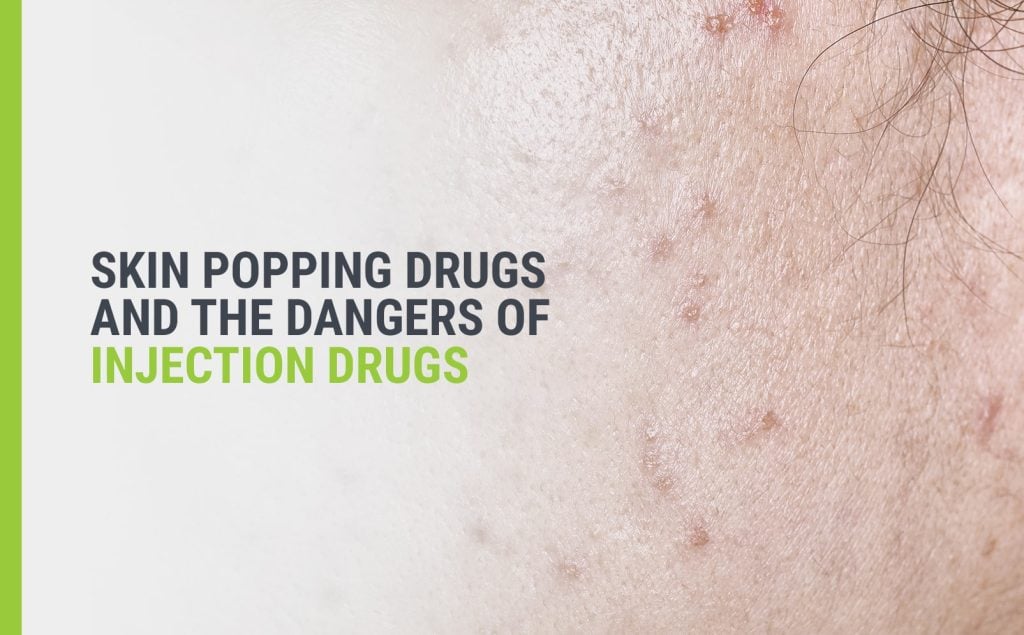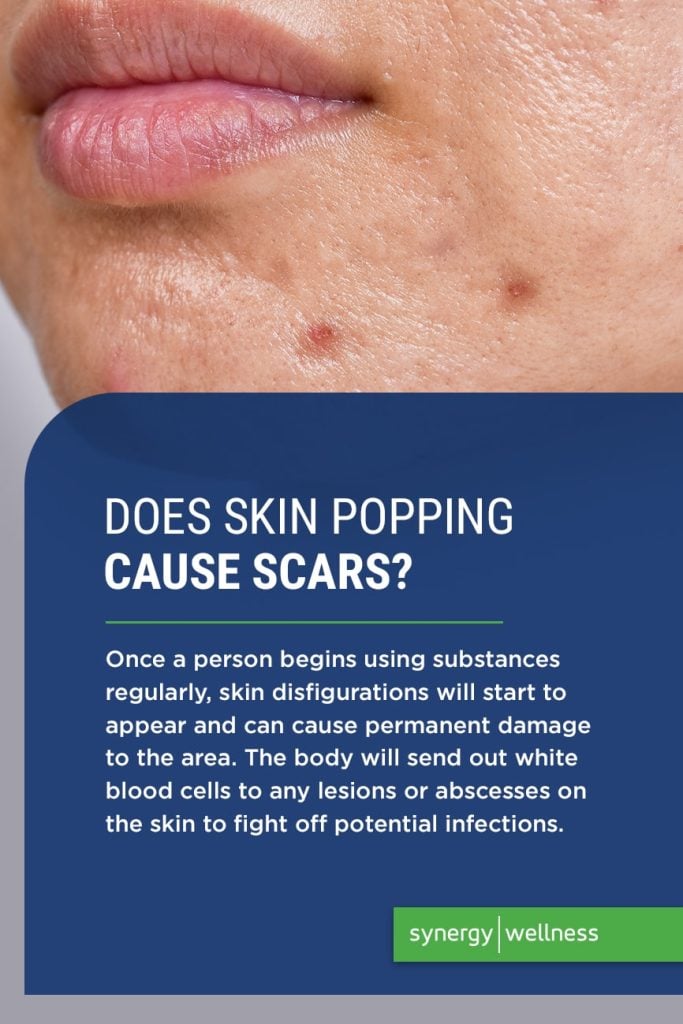
There are many ways to take or administer drugs such as cocaine, heroin and opioids. The most popular methods include smoking, snorting or injecting. However, some people don’t use these methods to administer a substance. Instead, they choose skin popping to take a drug, which is a method of injecting substances into the body.
Those who practice skin popping put themselves at risk for various health conditions, including addiction and overdose. Continue reading to learn more about skin popping drugs and the associated dangers.
What Does Skin Popping Mean?
Skin popping refers to the intradermal or subcutaneous injection of various drugs, including heroin, opiates and cocaine.
Subcutaneous injections go directly under the skin, while intradermal injections go between the layer of skin and fat. Though they’re different, skin popping refers to either injection method and both ways are considered dangerous, especially compared to other forms of administering drugs.
Skin popping is associated with various health complications and can drastically impact a person’s well-being. Compared to intravenous injections, subcutaneous or intradermal injections absorb the drug slower. The drug’s effects may last longer as a result. The drug will also stay in a person’s system longer, which can cause a person to use too much of the substance.
A person can develop an addiction, which risks different physical and mental health problems. A person can also overdose using this method, which can be fatal. Overdose from injecting drugs is more common than you might think, with 41.5% of users experiencing a least one non-fatal overdose in their lifetimes.

Why Do Drug Users Use the Skin Popping Method?
There are many reasons a person might choose the skin popping method over something else, including:
- Lack of viable veins: If someone has been injecting heroin, cocaine, opioids or other drugs into their veins for a long time, their veins could have become so damaged that they have difficulty finding a viable vein. Long-term intravenous injections can cause veins to harden or scar, limiting their access to their primary veins. Once a person starts going through drug withdrawal, they might give up trying to find a vein and inject the substance straight into their skin.
- Long-lasting effects: Some people choose skin popping because they want the impact of the drug to last longer. Subcutaneous and intradermal injections take longer to absorb into the bloodstream, prolonging the drug’s effects. Still, skin popping doesn’t create the same rush that many people with substance use disorders are used to. Some people will only use skin popping as a last resort, but others will purposefully choose it to delay the onset of the effects and make them last longer.
- Lack of knowledge: Many people who use drugs have no experience in the medical field, meaning they don’t know how to find their veins and inject the substance. If someone with limited or no knowledge of the subject tries to inject a drug into their veins, they may miss and inject it into their skin instead. Other people may not know the difference between intravenous injection and skin popping and might inject the drug into their skin because they don’t know any better.
Skin Popping Heroin and Other Opiates
Heroin is one of the most commonly injected substances, but other opioids, such as oxycodone and morphine, are also injected. Opiates are central nervous system depressants and, when taken, cause a person to feel:
- Euphoria
- Numbness
- Drowsiness
- Disorientation
- Flushed skin
- Heaviness in the arms and legs
- Dry mouth
- Itching
- Slowed breathing
- Slow heart rate
- Clouded thinking
When a person uses opioids, the drug passes the blood-brain barrier and binds to the opioid receptors. They also affect your brain’s reward center, altering how you think and process information. You may also have an altered reaction to the world around you, and your sleeping and eating habits can be affected.
If a person chooses skin popping to take heroin or other opiates, it can take anywhere between five to eight minutes to start feeling the euphoric high. The high will last longer from skin popping than from an intravenous injection since skin popping releases the drug slowly.
The danger is that a person might take a higher dose. A person might also take a second dose if they tried to inject the drug into their veins and unknowingly missed the area. If they don’t feel the rush immediately like they’re expecting, a person might think that they haven’t taken enough.
A higher or second dose can cause a person to overdose, which has the potential to be fatal. A heroin or opioid overdose looks like:
- Disorientation
- Loss of consciousness
- Confusion
- Weak pulse
- Shallow or slow breathing
- Convulsions
- Low blood pressure
- Muscle spasms
- Inability to breath
- Coma
If you or a loved one is experiencing a heroin overdose, it’s essential to seek medical assistance as soon as possible.

Skin Popping Cocaine
Cocaine is a stimulant that affects a person’s central nervous system. Choosing to inject cocaine allows the drug to enter the bloodstream directly, intensifying its effects, including euphoria and health consequences.
When a person injects cocaine, they might experience:
- An intense euphoric effect
- Dilated pupils
- Elevated alertness
- Increase in energy
- Hypersensitivity to light, sounds and touch
- Suppressed appetite
- Increased heart rate and blood pressure
- Elevated blood pressure
A high dosage when skin popping coke can cause erratic or violent behavior, paranoia and uncontrollable tremors. These symptoms could indicate an overdose, which can result in a heart attack, stroke or seizure. If you notice these signs in yourself or another person, it’s essential to seek medical help immediately.
What Are Some Health Risks Involved With Skin Popping?
Administering illicit drugs always comes with health risks, but skin popping has unique negative effects on the body. A person who does skin popping risks:
Bacterial Infections
When a person chooses skin popping, they put themself at risk for various bacterial infections, including:
- Wound botulism: Wound botulism is caused by bacteria entering wounds and creating toxins. Once the toxin enters the body, it attacks the nerves and makes it difficult to breathe. Other symptoms include double or blurred vision, drooping eyelids, difficulty swallowing and respiratory failure.
- Necrotizing fasciitis: Necrotizing fasciitis is sometimes known as “the flesh-eating bacteria.” Once the bacteria enters the body, it can spread quickly and damage or kill soft tissue. Symptoms of necrotizing fasciitis include swollen and red skin that quickly spreads, pus at the area of infection, ulcers or blisters, severe pain and fever.
- Tetanus: Tetanus is caused by bacteria that create toxins. Once the toxins enter the body, they can cause uncontrollable muscle contractions that are often painful. It can also cause the mouth and jaw to lock up, making it challenging to swallow. Tetanus is preventable with a vaccination.
If some of these conditions are left untreated and become severe enough, the only other option might be amputation, which means you could lose one of your extremities.
Loss of Blood Flow
Repeatedly injecting a substance into the skin can cause the area to become stiff or scarred. The damage can become so severe that the injection site can lose blood flow completely. A loss of blood flow can result in muscular atrophy, which causes an area of muscle to waste away or become thin, resulting in weak extremities.
Bloodborne Diseases
If you’re skin popping substances, you risk contracting bloodborne diseases, such as HIV and hepatitis. When you use heroin, opioids or cocaine, your inhibitions lower, and you might be more likely to share needles with another person. Many bloodborne illnesses can cause severe long-term effects, such as human immunodeficiency virus (HIV).

Does Skin Popping Cause Scars?
Long-term skin popping can cause scarring, lesions and abscesses.
Once a person begins using substances regularly, skin disfigurations will start to appear and can cause permanent damage to the area. The body will send out white blood cells to any lesions or abscesses on the skin to fight off potential infections.
When these areas are healed, scar tissue will remain in its place. Scars will form wherever a person injects the drug, including the hands, fingers, wrist, forearms, legs and toes. Even once a person stops using drugs, the scars can remain for years, if not permanently.
Skin popping causes abscesses and lesions since germs can sit in the fat or muscle tissue. These areas are prime locations for bacteria to fester into infections. These infections can become severe if they spread to the bones, blood, heart or other sites in the body. Immediate treatment is necessary to prevent long-term damage and even death.
Laser Resurfacing Treatment for Scarring
If you have skin popping scars, you don’t have to live with these scars forever. Synergy Wellness offers Morpheus8 treatment for scarring to help improve the appearance of your skin. The minimally invasive procedure uses an array of microneedles to gently ablate the skin. These devices also supply fractionated radiofrequency (RF) to the skin to heal the layers of the epidermis.
Your body will respond to laser resurfacing treatment by producing more collagen and elastin, which are essential proteins the body produces naturally and keeps your skin healthy and radiant. Collagen and elastin can help repair tissue and smooth and tighten your skin.
Laser resurfacing treatment can be performed on any part of the body. If skin popping has caused scarring from injections, abscesses or lesions in various locations, you can rest assured that Morpheus8 treatment can help you repair damaged skin. The different arrangement of microneedles allows our technicians to target specific areas, no matter the size.
The whole procedure takes approximately an hour or two, depending on the part of your body being treated. You’ll have very minimal downtime after treatment, so you can get back to your regular schedule immediately. After the procedure, the area might look slightly wind-burnt, but the effect should go away within a few days or a week. You can see improvements in as little as a day or two. As time goes on, your skin will continue to improve.
When you come in for treatment, Synergy Wellness will examine your skin to determine the best treatment method for your skin. We’ll walk you through each step of the process to make it as seamless as possible. Contact us to schedule a consultation and learn more about laser skin resurfacing.
Addiction Treatment
If you’re struggling with addiction and skin popping, there are various treatments to help you reach sobriety and reclaim your life. Treatment can help people handle withdrawal and prevent a relapse by teaching them how to manage triggers and cravings.
Once a person goes through detox, they can start official treatment, which may include:
- Cognitive behavioral therapy (CBT): CBT helps people recovering from addiction understand how their beliefs, thoughts and feelings influence their actions. A therapist will help someone identify automatic negative thought patterns and new responses to these thoughts and associated feelings. Rather than turning to substances when experiencing negative emotions, CBT teaches individuals healthy coping mechanisms to handle uncomfortable feelings and situations.
- Dialectical behavioral therapy (DBT): DBT encourages individuals to accept their uncomfortable thoughts and feelings rather than pretend they don’t exist. A big part of DBT relies on learning new coping skills to achieve emotional regulation.
- Mental health treatment: Addiction and mental health conditions often exist simultaneously, usually called co-occurring disorders. Some people use drugs to cope with uncomfortable feelings and symptoms. Effective addiction treatment will also treat mental health conditions to reduce people’s desire to use substances and improve their well-being.
- Individual and group therapy: Addiction treatment combines individual and group therapy to learn how to apply their skills to triggering situations and connect with others who share similar experiences. Support and connections fostered during group therapy can help you feel less isolated during your treatment and gives you a space to ask questions or express your challenges.
- Mindfulness and stress management: Mindfulness allows you to recognize your current emotional state without acting on these feelings. Rather than relying on drugs to cope, a person will learn skills to manage their stress and improve their reaction to challenging situations.
- Peer support groups: Many people in addiction treatment participate in 12-step programs to maintain accountability during treatment and find support during difficult situations. These groups are an excellent place to connect with others who share your experiences, ask questions and express your feelings throughout the recovery process.
Seek Recovery From Addiction at Synergy Wellness
Are you or someone you love struggling with addiction? Let Synergy Wellness assist you in finding your way to recovery. Our addiction treatment programs help individuals in Bakersfield, California, find relief from their symptoms and achieve sobriety. We offer outpatient treatment for individuals who would like to continue living at home during their treatment. During the day, you’ll attend treatment and counseling and return home once you’ve completed your sessions.
We can help you detox from substances and learn healthy coping skills to manage uncomfortable feelings or triggering situations. We also offer mental health treatment to help increase your chances of long-term success. Contact us today to learn more about our addiction treatment services and how we can help you reclaim your life.




